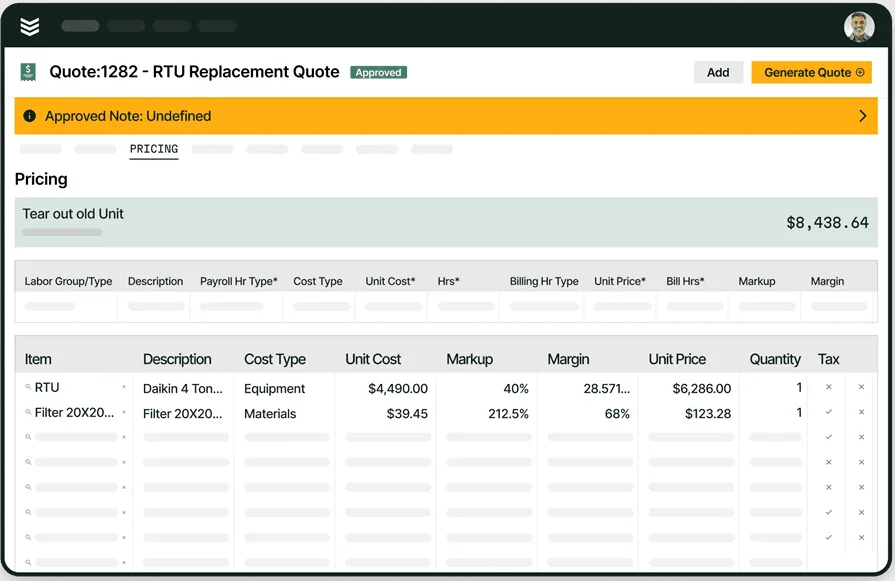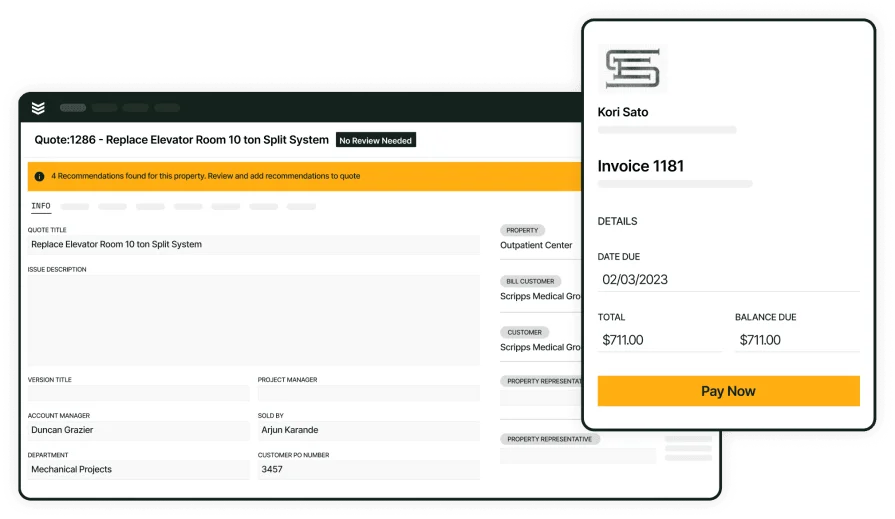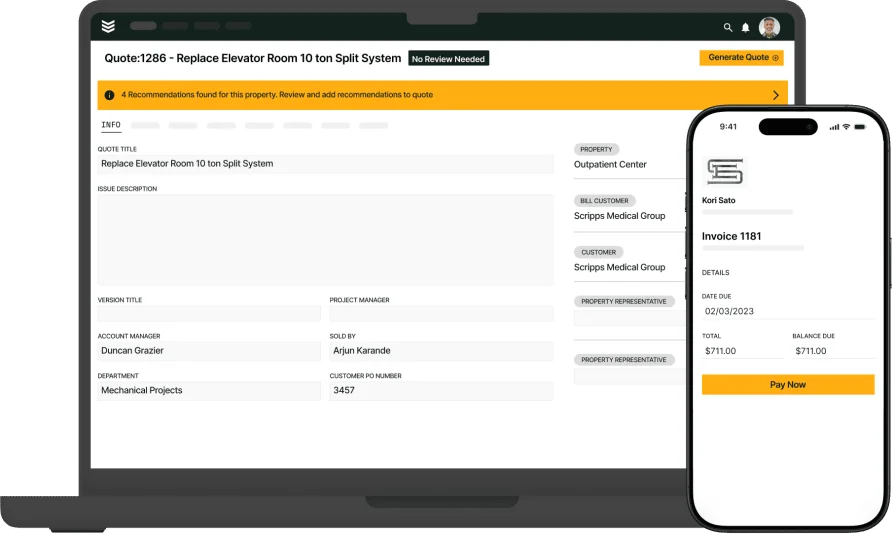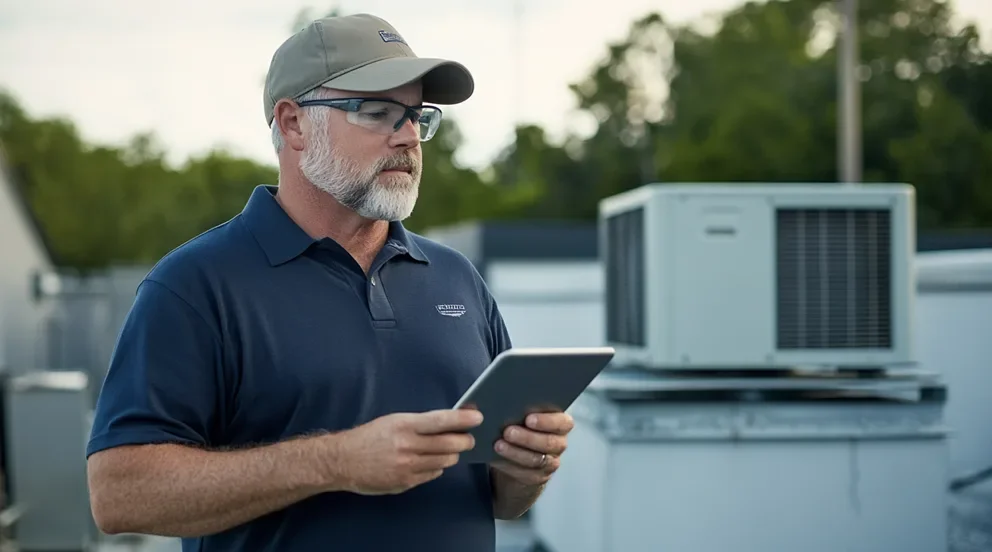Creating accurate estimates is one of the biggest challenges HVAC businesses face. Price a job too low, and you cut into your profits. Go too high, and you risk losing the customer. Overcoming these issues starts with good HVAC software, and it’s also where an estimating app makes all the difference.
With the right tool, contractors can generate fast, precise estimates on-site, ensuring competitive pricing and maximizing profitability. Whether you’re handling residential repairs or large commercial projects, accurate estimates and a profitable business are achievable with software that is built for you. In this guide, we’ll break down everything you need to know about HVAC estimator apps, including:
- Choosing the right HVAC estimating app
- 6 key features to look for in an HVAC estimator app
- Types of HVAC estimating apps
- 7 best HVAC estimate apps to improve your bidding process
- 7 benefits of using an HVAC estimating app
- 4 important HVAC estimator app FAQs answered
Selecting the right HVAC estimating app requires considering how well it aligns with your business operations. Before exploring key features, let’s first look at what factors to consider when choosing the best solution.
Choosing the right HVAC estimating app
Every job starts with an estimate. Get it right, and you win the bid while protecting your profit margins. Get it wrong, and you risk underbidding or scaring off potential customers. The best estimating apps don’t just spit out numbers. They help you price jobs accurately, adjust for labor and materials in real-time, and generate professional estimates that build customer confidence. But not all apps are built the same.
So, how do you find one that fits the way your business operates? Keep these five key factors in mind:
- Ease of Use – Your estimating app should be fast and intuitive. If it takes more time to learn than it does to write estimates manually, it’s not the right tool.
- Mobile Accessibility – Whether you're in the office or on-site, you should be able to build, adjust, and send estimates straight from your phone or tablet.
- Integration with Other Software – The best apps sync with your scheduling, invoicing, and job management tools, keeping everything connected from estimate to final payment.
- Customization & Pricing Accuracy – Every job is different. A good app lets you modify pricing, labor rates, and materials instantly to reflect real-world costs.
- Features – From pre-built templates to automated calculations and digital approvals, the right estimating app should speed up your workflow—not slow it down.
Picking the right estimating tool is about giving your HVAC business a competitive edge. Next, we’ll break down the must-have features that make an estimator app truly stand out.
6 key features to look for in an HVAC estimator app
An HVAC estimator app should do more than just crunch numbers—it should make estimating faster, more accurate, and easier to manage. HVAC contractors deal with fluctuating material costs, labor pricing, and tight deadlines, so having an app that automates calculations, tracks job expenses, and integrates with other tools can be a game-changer. The right features ensure estimates are precise, professional, and ready to send before you even leave the job site.
1. Instant estimates with real-time pricing
Speed and accuracy can mean the difference between winning a job and losing it to a competitor. A good estimator app should generate detailed, professional estimates in minutes while pulling in real-time pricing for labor and materials. For example, when quoting an emergency HVAC system replacement, a contractor needs a tool that instantly calculates costs and accounts for markups. With an HVAC estimating software that integrates with invoicing, contractors can ensure estimates transition seamlessly into billing, reducing errors and streamlining cash flow.

Curious how BuildOps can help?
We streamline job quotes so you can estimate projects with confidence.
2. Mobile estimating for on-site quotes
HVAC technicians and sales teams shouldn’t have to wait until they’re back at the office to create estimates. A mobile-friendly app allows them to build, edit, and send estimates straight from the job site using a tablet or smartphone. Imagine a technician inspecting an aging rooftop unit at a commercial property—rather than jotting down rough numbers and calling the office later, they can input details into a field service estimator app for HVAC technicians, ensuring instant and accurate quotes.
3. Seamless scheduling and dispatch integration
An estimator app should work hand-in-hand with your scheduling and dispatch system to keep everything running smoothly. Once an estimate is approved, the system should automatically generate a job order and assign technicians without manual data entry. Think about an HVAC business securing a contract for a multi-unit system replacement—without proper integration, office staff would need to manually transfer job details, increasing the chance of scheduling errors. With an HVAC estimating tool that connects to scheduling software, teams can move from estimate to execution without delays.
4. Custom pricing for different job types
Not all HVAC jobs fit into a one-size-fits-all template. Your estimator app should allow you to adjust pricing, labor rates, and materials based on project size, location, and customer requirements. For example, when quoting both a small residential furnace replacement and a large-scale VRF system installation, a contractor needs flexibility in pricing. With HVAC estimating software that integrates with CRM tools, businesses can store customer-specific pricing, apply custom markups, and maintain consistency across estimates.
5. Job costing and financial tracking
A strong estimator app should do more than just provide numbers—it should help HVAC contractors track job costs and profitability. Features like automated cost tracking, pre-built estimate templates, and job-specific reporting ensure that every estimate is backed by real financial data. For instance, when preparing a bid for a large ductwork retrofit, contractors need an HVAC estimating solution with reporting tools to analyze job expenses and adjust pricing strategies.
6. Digital approvals for faster job sign-offs
Speeding up the approval process is key to securing more jobs. A great estimator app should allow customers to review and approve estimates digitally, reducing delays and miscommunication. Picture this: a technician submits an estimate for an urgent compressor replacement, but the customer isn’t on-site. Instead of waiting for a callback, they can send the estimate via the HVAC estimating platform with built-in digital approvals, allowing the customer to sign off remotely.
Other useful features of HVAC estimating apps
Beyond core estimating functions, the right HVAC estimator app should include additional tools that improve efficiency and streamline operations. Here are three extra features that can take your estimating process to the next level:
- Time tracking for labor costs – Accurately tracking labor hours ensures estimates reflect real job costs. A time tracking feature in estimator apps automatically logs technician hours, helping contractors avoid underpricing labor.
- Fleet tracking for job-site efficiency – Estimator apps that sync with fleet management software help businesses assign the right technicians to jobs, reducing delays and ensuring estimates include accurate travel costs.
- Built-in payment processing – Some estimating apps allow contractors to collect deposits or full payments directly from the estimate, speeding up the payment cycle. A payment processing tool for estimating ensures smoother transactions and better cash flow.

Download the HVAC safety checklist
Ensure every bid accounts for the right materials, labor, time, and safety constraints.
An HVAC estimator app is the backbone of a smooth and profitable bidding process. Next, we’ll explore the different types of estimating apps available and which one best fits your business needs.
Types of HVAC estimating apps
HVAC estimator apps come in different formats, each designed to fit specific business needs and workflows. The right choice depends on factors like mobility, accessibility, and how well the app integrates with your existing systems. Here are the three main types:
- Desktop software: Installed on office computers, desktop-based estimator software offers robust features for job costing, material tracking, and reporting. It’s ideal for contractors who primarily handle estimates from a fixed location and need detailed financial oversight.
- Cloud-based solutions: These apps store data online, allowing technicians and office staff to create, edit, and send estimates from anywhere with an internet connection. Cloud-based tools are great for HVAC teams that need mobility and real-time collaboration across multiple job sites.
- Mobile estimating apps: Designed for field technicians, mobile estimating apps enable on-site estimate creation, customer approvals, and quick modifications. They speed up the sales process but may lack the advanced job costing and reporting features of full-scale desktop or cloud-based solutions.
Each type serves a different purpose, whether it's providing detailed financial tracking, ensuring real-time access to estimates, or enabling field teams to send bids on the go. For HVAC businesses that need an all-in-one solution combining estimating, job management, and financial tracking, BuildOps offers a commercial-focused platform designed to improve efficiency and accuracy.
7 Best HVAC estimate apps to improve your bidding process
Choosing the right HVAC estimate app can transform how your business creates bids, manages job costs, and wins contracts. The best apps provide fast, accurate estimates while integrating seamlessly with your existing workflows. Whether you focus on commercial projects, residential services, or a mix of both, there’s an HVAC estimating app built for your needs. Here are seven top-rated estimating apps designed to help HVAC businesses improve their bidding process:
1. Best for commercial contractors: BuildOps
BuildOps is built specifically for commercial HVAC contractors, offering an all-in-one estimator app that simplifies bidding for large-scale projects. From material takeoffs to final proposals, it ensures estimates are accurate, professional, and competitive. The app integrates seamlessly with job costing, scheduling, and invoicing tools, keeping the entire estimating process efficient and connected.
How pricing works: BuildOps uses a customized pricing model tailored to business size and specific needs. This way, contractors only pay for the features that directly impact their estimating and bidding workflows.
Features beyond estimating:
- Real-time tracking of job costs and profitability
- Automated labor and material calculations for precise bids
- Seamless integration with scheduling and invoicing to streamline operations
What sets it apart for commercial: Unlike generic estimating apps, BuildOps is designed for the complexity of commercial HVAC work. With tools that automate cost tracking, speed up bid creation, and integrate with key business systems, it helps contractors stay competitive while reducing manual work. Whether bidding on a multi-unit HVAC retrofit or a full system installation, BuildOps ensures estimates are detailed, accurate, and ready to win contracts.

Explore our estimating product
We help commercial contractors streamline bidding and improve job profitability.
2. Best for residential contractors: Housecall Pro
Image Source: Housecall Pro
Housecall Pro is a great choice for residential HVAC contractors, offering easy-to-use tools for estimating, scheduling, and client communication. Its intuitive interface allows small teams to generate and send estimates quickly, ensuring homeowners receive accurate quotes without delay. While it excels in residential HVAC estimating and job management, it may not be the ideal solution for contractors handling large-scale commercial projects. Its features are geared toward smaller teams and lack the advanced cost-tracking and integration capabilities required for complex, multi-phase jobs.
How pricing works: Housecall Pro offers tiered pricing plans, allowing businesses to choose a package that best aligns with their size and operational needs.
Features beyond estimating:
- Built-in scheduling and dispatching tools
- CRM features for customer relationship management
- Mobile app for on-the-go estimate creation
What sets it apart for residential: Housecall Pro is built with residential contractors in mind, focusing on simplicity and efficiency. Its all-in-one platform allows HVAC businesses to send estimates, manage customers, and schedule jobs seamlessly—all from a mobile device.
3. Best for general contractors: Jobber
Image Source: Jobber
Jobber is a versatile estimating app that works well for HVAC businesses handling both residential and light commercial projects. It provides an easy-to-use platform for creating professional estimates, tracking jobs, and managing client relationships. With a focus on field service businesses, Jobber simplifies the estimating process without unnecessary complexity.
How pricing works: Jobber offers multiple pricing tiers based on the number of users and features required, making it accessible for small and mid-sized HVAC businesses.
Features beyond estimating:
- Customizable estimate templates for different job types
- Automated follow-ups to improve bid conversion rates
- Mobile accessibility for field technicians
What sets it apart for general use: Jobber balances affordability with functionality, making it ideal for HVAC contractors who need an estimating tool that works across different job types. It helps businesses create professional estimates, stay organized, and win more jobs with minimal administrative hassle.
4. Best for takeoffs in construction: STACK
Image Source: STACK
STACK is a cloud-based estimator and takeoff software designed for contractors who need fast and accurate bid preparation. It allows HVAC businesses to measure plans, create estimates, and generate proposals all in one platform. While STACK is widely used for takeoffs in construction, its estimating capabilities make it a strong option for HVAC contractors managing mid-to-large-scale projects.
How pricing works: STACK offers a tiered subscription model with pricing based on the number of users and features required. It provides a free trial, making it easy for contractors to test its functionality before committing.
Features beyond estimating:
- Cloud-based takeoff tools for measuring and quantifying materials
- Pre-built HVAC material databases for quick and accurate estimates
- Proposal generation tools for professional bid submissions
What sets it apart for HVAC contractors: STACK excels at takeoffs, allowing HVAC businesses to create precise estimates directly from digital blueprints. Its cloud-based platform makes collaboration easy, ensuring contractors can adjust bids in real-time from anywhere.
5. Best for streamlining HVAC workflows: Estimate Rocket
Image Source: Estimate Rocket
Estimate Rocket is an all-in-one estimator and project management tool that helps HVAC contractors streamline their workflow from the initial bid to final invoicing. It is particularly useful for small to mid-sized HVAC businesses that need a simple, intuitive tool for generating and tracking estimates.
How pricing works: Estimate Rocket operates on a monthly subscription model with different plans based on business size. It offers a free trial, making it accessible for businesses looking to test its features before committing.
Features beyond estimating:
- Automated follow-ups to improve bid conversion rates
- Built-in job scheduling and project tracking
- Mobile-friendly interface for on-the-go estimating
What sets it apart for HVAC businesses: Estimate Rocket’s automation features help contractors close deals faster by streamlining follow-ups and approvals. It’s a great fit for HVAC businesses that want a user-friendly estimating tool with built-in job tracking.
6. Best for seamless QuickBooks integration: FieldEdge
Image Source: FieldEdge
FieldEdge is a field service management platform with built-in estimating capabilities, making it a great option for HVAC businesses that want an all-in-one solution. It offers real-time pricing updates, customer management tools, and seamless integration with QuickBooks for easy invoicing.
How pricing works: FieldEdge follows a subscription-based pricing model, with costs depending on the number of users and features required. Pricing is customized based on business needs.
Features beyond estimating:
- Customer management tools for storing service history and preferences
- Real-time inventory tracking for accurate material pricing
- Seamless integration with accounting and dispatching software
What sets it apart for HVAC contractors: FieldEdge is ideal for businesses looking for an estimator tool that integrates with their entire field service operation. Its ability to track inventory, manage customers, and generate estimates in real time makes it a strong choice for HVAC contractors handling frequent service calls.
7. Best for ductwork estimating: FastDUCT
Image Source: FastDUCT
FastDUCT is an estimator solution designed specifically for HVAC and ductwork contractors. It offers advanced takeoff tools, material cost tracking, and labor calculations to help businesses create accurate bids for duct fabrication and installation projects.
How pricing works: FastDUCT uses a one-time licensing fee rather than a subscription model, making it a cost-effective option for HVAC businesses that prefer a single upfront investment.
Features beyond estimating:
- Specialized ductwork takeoff and estimating tools
- Pre-loaded labor and material cost databases
- Custom reporting features for tracking estimate performance
What sets it apart for ductwork estimating: FastDUCT is one of the few estimating solutions built specifically for HVAC sheet metal and ductwork contractors. Its advanced takeoff tools and cost databases make it ideal for businesses focused on large-scale duct system installations.
7 benefits of using an HVAC estimating app
The right HVAC estimate app does more than just generate quotes—it helps contractors work faster, reduce errors, and close more deals. Whether you're bidding on a commercial installation or a residential repair, having a mobile, accurate, and fully integrated estimating tool gives you an edge over the competition.
By automating calculations, improving collaboration, and streamlining approvals, an estimator app ensures that HVAC businesses can focus on winning jobs and maximizing profits. Here’s how an HVAC estimating app benefits contractors the most:
1. Faster estimates and improved bid turnaround
In estimating for HVAC, speed matters. The longer it takes to submit a bid, the more likely a competitor will beat you to the job. With an HVAC estimator app that updates in real time, contractors can instantly pull material costs, apply labor rates, and generate accurate quotes on-site. This means fewer delays and a higher chance of securing contracts before the competition.
2. Higher profit margins with accurate cost tracking
Small miscalculations can turn a profitable job into a financial loss. Underestimating labor, forgetting to include overhead, or failing to adjust for material price fluctuations can eat into profits. An HVAC estimating app built for commercial contractors eliminates guesswork by tracking costs in real time and applying consistent markup rates. This ensures every bid covers expenses while staying competitive.
3. Consistent estimates across your team
When multiple technicians or sales reps create estimates, inconsistencies in pricing and formatting can lead to confusion and lost revenue. A standardized HVAC estimate template within an app ensures every bid follows the same structure, pricing model, and professional layout. This improves transparency and helps teams present estimates that customers trust.
4. Reduced job site delays and scheduling conflicts
An accurate estimate isn’t just about landing a job—it also helps with scheduling and job planning. HVAC estimator apps allow businesses to break down labor, materials, and timelines in advance, ensuring the right resources are allocated before work begins. This results in fewer project delays, better crew scheduling, and an overall smoother workflow.
5. Fewer errors and cost overruns
Unexpected expenses can quickly pile up without precise estimates. Miscalculating material quantities, failing to account for subcontractor costs, or overlooking potential job site challenges can lead to budget overruns. A well-designed HVAC estimator app with automated cost tracking flags potential cost gaps before they turn into financial setbacks, ensuring projects stay within budget.
6. Faster client approvals with digital estimates
Winning a bid is also about presentation. Customers want clear, professional estimates they can review and approve without hassle. An HVAC estimating app with digital proposal features allows contractors to send branded, easy-to-understand quotes that clients can approve electronically. This speeds up the approval process, reducing back-and-forth communication and securing jobs faster.
7. Seamless transition from estimate to invoice
Once an estimate is approved, it should easily convert into an invoice without requiring manual data entry. An HVAC estimator app that integrates with invoicing and job management tools ensures that estimates become actionable, reducing administrative workload and eliminating duplicate data entry. This keeps operations moving smoothly from bid to payment.
An HVAC estimate app optimizes your entire workflow. Next, we’ll answer some of the most common questions contractors have about HVAC estimating apps and how to choose the best one for your business.
4 important HVAC estimator app FAQs answered
Choosing an HVAC estimating app comes with questions. Contractors want to know how these tools fit into their workflow, improve accuracy, and help them win more jobs. Here are answers to some of the most common questions about HVAC estimator apps.
1. What is an HVAC estimating app?
An HVAC estimator app is a tool that helps contractors create detailed estimates while on the go. It calculates labor, materials, and overhead costs while ensuring pricing stays competitive. Many apps also integrate with scheduling, invoicing, and job management systems to streamline operations.
2. How does an HVAC estimating app improve billing accuracy?
Manual estimating leaves room for miscalculations and missed costs. An app automates calculations, applies consistent pricing structures, and pulls real-time material costs, reducing errors and ensuring estimates reflect actual project expenses. This helps contractors avoid underbidding and ensures profitability.
3. Who should use an HVAC estimating app?
HVAC business owners, sales teams, and field technicians can all benefit from using an estimator app. Whether you're creating bids for residential service calls or large commercial installations, an app helps standardize pricing, speed up approvals, and improve efficiency across the team.
4. Can an HVAC estimating app integrate with other business tools?
Many HVAC estimating apps integrate with scheduling, invoicing, and customer relationship management (CRM) software. This allows contractors to convert estimates into work orders, send invoices without re-entering data, and keep job details organized in one place.
An HVAC estimator app helps contractors bid faster, improve accuracy, and keep their business profitable. From real-time pricing updates to seamless integrations with scheduling and invoicing, the right tool ensures every estimate is backed by solid data and built for efficiency. Whether you’re working on residential service calls or large-scale commercial projects, having a reliable estimating app keeps your team organized and ahead of the competition.
For commercial contractors needing an all-in-one solution, BuildOps offers a platform designed specifically for field service businesses. With estimating, scheduling, job management, and invoicing in one system, it simplifies operations and eliminates the need for multiple disconnected tools.

Want to see how it works?
We streamline estimates so you can win more project bids and get paid faster.











